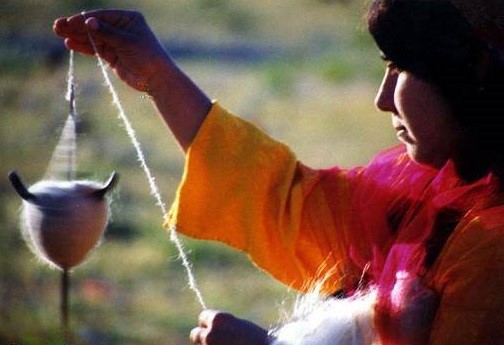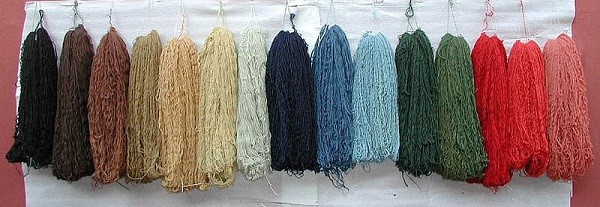wool spining history
The history of spinning is very old. It is generally agreed that the spinning of fibres to form a thread or yarn has been in existence for over 10,000 years. The drop spindle was the primary spinning tool for almost 9000 years, it was used to spin all the threads for clothing and fabrics from Egyptian mummy wrappings to tapestries, ropes and sails for ships. In early times the yarn was hand spun. After industrialisations the yarn started to be spun using carding machines and mules using steam power. After industrial modernisation of Europe the yarn spinning was developed into Ring Spinning using electrical power. During 90’s modern machineries were introduced having state of art Electronic clearing devices, filament yarn, friction spinning etc.
traditional wool spining types of world
Through out the world, there are three traditional system to spin Woollen or wool blended yarns i.e.
- Woollen System yarn also called as carded yarn or condenser yarn suitable for any need be it Apparel or furnishings. Incidentally most popular as it is most cost efficient way to produce yarn.
- Semi Worsted yarn is short version of worsted yarns and used only for furnishing yarns such as carpets, Rugs and upholstery.
- Worsted yarn is costliest spinning system in traditional system and incidentally used only for apparels. There are evidence of use of worsted yarns for Rugs but that is a mere fraction of above two.
wool spining to weave a persian handmade carpet

Carded and washed wool, silk, and cotton fibers need to be spun into yarns before they can be woven. At the simplest level this can be done by pulling some fibers out of a cluster of carded wool or cotton and rubbing them back and forth between the palms. A weight or spindle whorl can be attached to one end of the fibers to allow gravity to facilitate the process, making the spinning tighter. Hand spinning can also be aided by use of a spinning wheel. Since the fibers of cotton and especially silk are much finer than wool, a spinning wheel is more of a requirement in turning these materials into yarns. Individual spun yarns can then be plied together to make a stronger, cable- or rope-like yarn that is necessary in the warp threads of the rug foundation.

Machine spinning became common over the last century, but since it is so mechanically regular, machine-spun wool eliminates many of the textural, reflective variations that animate the surface of rugs made from hand-spun wool. Consequently, a revival of hand-spinning has accompanied the revival of natural dyes in the past twenty years.
effect of hand or machine spining on wool quality
The distinction between hand- and machine-spun wool is far from academic. The wool we are speaking of is the material used for the pile of a rug; for all practical purposes, it is the rug. Handspun and machine-spun wool have different properties that crucially affect how a rug looks.
Handspun wool yarn
Handspun wool yarn is irregular in the tension of its twist; it is inadvertently spun looser in some places and tighter in others. One practical effect of this irregularity is that, when soaked in dye, handspun yarn absorbs less where it is spun tightly and more where it is spun loosely. Without perhaps meaning to, the spinners have created yarn that, when dyed, is never uniform in color. Another practical effect of the lack of uniformity is a slightly uneven, ‘nubby’ surface on the rug. Because of these two factors — the irregularity of colors, and the rug’s irregular texture — such carpets have a very handmade look. During the first months of using rugs with handspun wool, owners notice that loose ends of the pile are pulled up by vacuuming. Pieces of pile stick up a half-inch to an inch above the rest of the pile. All rugs have this problem when they are new, though it is clearly more pronounced in carpets with handspun pile. Though it can be scary to rug owners, the phenomenon is harmless. The loose ends of pile can be and should be clipped the same height as the rest of the pile. If proper care has not been taken by the rugmaker in the clipping, the situation can, on rare occasions, be annoying enough to be considered a real problem — though one that affects the appearance of a carpet, never its longevity. Even though handspun wool is seen much more often today than even a few years ago, it still is found in only a small minority of new rugs.
Machine-spun wool
Machine-spun wool absorbs dye evenly. Color is uniform and the surface of a machine-spun wool rug is even. Machine-spun (sometimes referred to as mill-spun) wool in an Oriental rug looks quite different from handspun wool — at least in new rugs. (as rugs age and the pile is loosened with use, the difference between the two becomes less apparent.) Because the tension of its spin is so uniform, machine-spun wool absorbs dye evenly, and colors are more consistent. And because of the uniformity of the tension in machine-spun yarn, a rug made with it will have a very regular and finished look. You will easily be able to see the differences in handspun rugs and machine-spun rugs if you examine them side by side and look for the differences that described.
Structure of wool

- Wool is natural polymer with a strong, flexible, molecular chain structure
- Wool fibres are covered with overlapping scales tha provide protection, control the movement of water from the exterior to the interior (and vice versa), promote cohesion and enable wool to felt.
- The fibres have a wave-like crimp that enables air to be trapped within a yarn and gives it a springy, resilient handle
- Wool fibres suitable for carpets range from 30 – 40 microns in fibre diameter and 75 – 120 mm in length.
Benefits of wool as a carpet fibre
- Supply : A wide range of wool types are available in large quantities throughout the year
- Sustainability: A renewable resource, produced by environmentally-friendly farming methods
- Quality : Superior farm production systems, leading-edge scouring technology and objective testing ensure a clean, consistent, well-specified fibre
- Prestige : The long, proud tradition of wool carpets and rugs makes them the benchmark by which other carpets are compared
- Processing :Wool is easily processed into yarn and carpets using contemporary technologies
- Dyeability : Wool is readily dyeable to achieve an extremely wide range of shades Soiling and staining The unique surface of the fibre gives wool its easy-care properties – resistant to soiling and staining, and readily cleaned
- Flexibility : The intrinsic flexibility of wool enables a carpet pile to recover quickly after a foot fall (resilience), and to retain its texture very well in use (appearance retention)
- Durability: Good, long-term wear performance, especially when used in more dense-pile carpets; further enhanced when polyamide fibres are included
- Lustre: Wool is available in wide range of lustre levels which influence the sheen of a carpet surface
- Reaction to burning : Wool is the most resistant to burning of all carpet fibres and no toxic gases produced
- Effect of crimp : Fibre crimp promotes good thermal insulation and desirable carpet pile cover and resilience
- Chemical reactivity : Wool’s unique chemical structure is makes it resistant to attack by acidic solutions
- Electrostatic effects : The natural water-retaining properties of the fibre (~15%) mean that under normal conditions electrostatic shocks from carpets are imperceptible
- Indoor environment : Wool’s unique structure provides moisture buffering and absorption of odours




